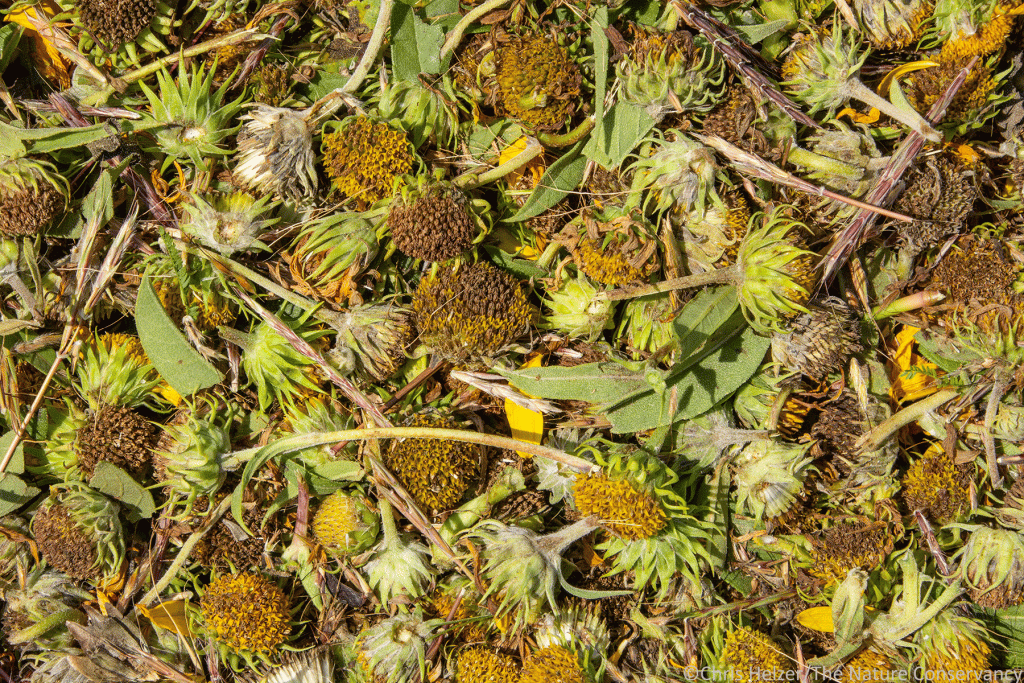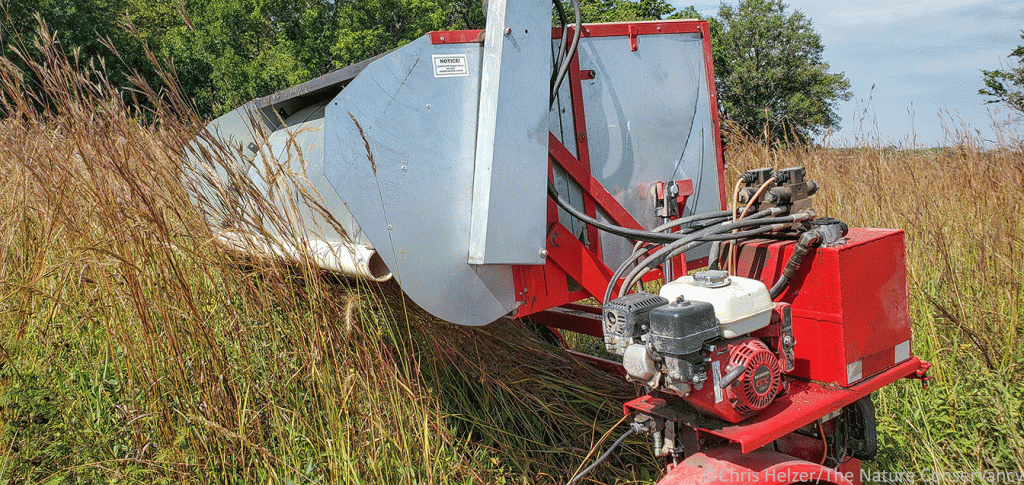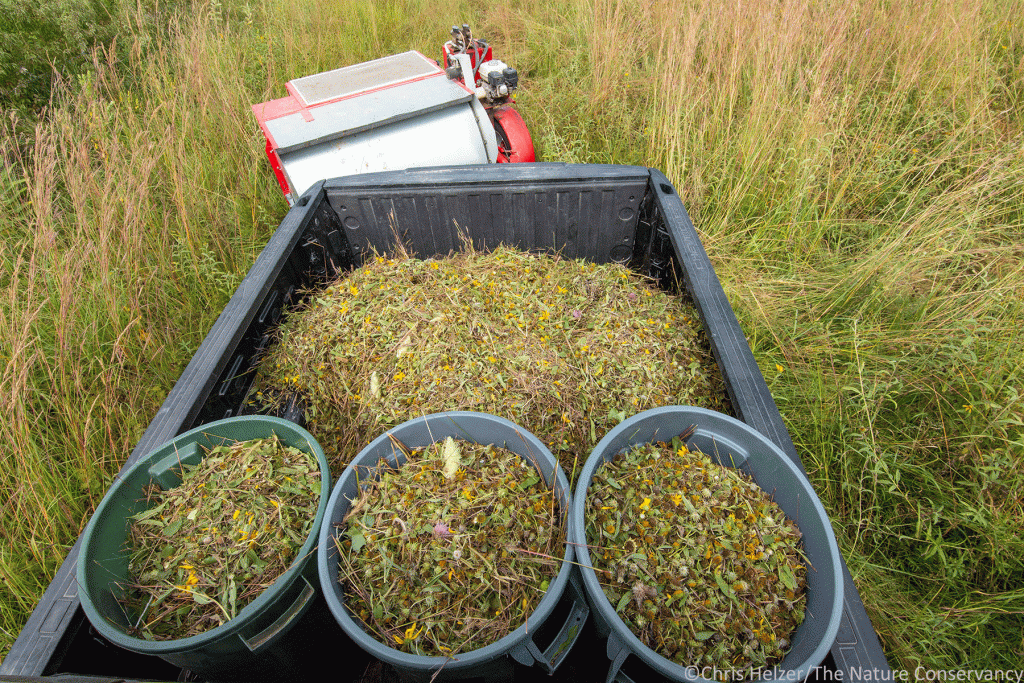I’ve been harvesting seed most of this week, while the rest of the Platte River Prairies crew was away at some fire training. It’s been a productive week, but hasn’t left me much time to write. As a result, I’m just putting up a quick post today that shares a few images and video from my seed harvesting.

We’ve been harvesting seeds all summer for two projects – (1) a 50 acre cropland restoration, and (2) continued overseeding of some degraded prairies. For the cropland restoration, we’re trying to harvest as many species as we can, including from wetland plants, since we’ll be doing some wetland construction at the site. We’ve been squeezing seed harvest in between lots of other work, so haven’t been able to get seed from all the species we want. As of today, I think we’ve gathered seed from 108 plant species, give or take, and we hope to get to at least 150 by the end of the season. The overseeding project requires a less diverse mix, but large amounts of seed. There are about 20-30 species we’re trying to add to pastures that are missing plants due to a history of overgrazing and broadcast herbicide use.
Most of those species are harvested by hand, which might seem inefficient if you’ve not been part of an effort like this. In reality, it’s surprising how much seed you can grab with your hands if you’re organized and diligent. We have a spreadsheet of plant species and constantly update it with the best sites to find large amounts of seed from each plant and when the seed is ripe. We’re constantly scouting for seed while doing other work too, keeping track of good populations we’ll want to return to later. Armed with that information, we strap buckets to our waists, wade into the prairie, and grab big handfuls (hopefully!) from each species.
This week, though, while I did some hand harvesting, much of my time was spent running a pull-behind mechanical harvester (seed stripper). I wrote about the particular machine we have several years ago, if you’re interested. We (meaning Nelson Winkel) have made a few minor modifications to it over time and it’s a great way to harvest large amounts of some species. The mechanical approach works best when there are big congregations of plants and an absence of invasive species we need to avoid. This week, I was using the seed stripper to harvest big grasses (big bluestem, Indiangrass, switchgrass, etc.), perennial sunflowers (stiff, Maximilian, and sawtooth), and a mixture of big summer wildflowers (Illinois bundleflower, wild bergamot, showy tick trefoil, and others).



It’s very gratifying work and also provides a lot of time to contemplate and dream. In fact, I came up with a couple different blog post topics while I was zoning out on my ATV. I also got to watch lots monarchs and other pollinators, scare up migratory sparrows from their hiding places, and even got temporarily mobbed by bumblebees when I stopped the running machine over the top of their nest. (Sorry about that, bumblebees!)
In addition to the few photos I’m including here, I’ve also put together a very rough and amateurish video that shows what the seed stripper looks like in action. For what it’s worth, here’s the video.

Very cool to see the processes used as various sites . . .
What information is on your spreadsheet? Location, species present, date of ripening, size of collection site. What else?
That’s pretty much the list. Species, when it is ripe, and locations we’ve found good populations in the past. And I use a numbering system, rather than specific dates) to indicate roughly the order that they’ll be ready because it can vary a lot year to year. The numbers indicate the average week of the season (starting from whenever our first species is ready – usually Antennaria) we’ve normally found ripe seed for each species. We’re always looking several weeks ahead, though, to make sure we’re not missing anything that ripens faster than expected. It at least gives us a system for keeping track of what’s coming up.
I try to update the spreadsheet periodically, but definitely create smaller subset lists for our crew throughout the season that show what might be ready in the next few weeks and that includes where we’ve seen populations this year. In some cases, I also try to indicate how much we might need (by volume) to give them an idea of how much effort to put into each species. The latter is definitely more art than science, but at least gives them something to shoot for so they don’t spend all day looking for more of something that’s hard to find or harvesting hundreds of gallons of something that will likely show up on its own.
The same spreadsheet than works as a checklist for us to keep track of what’s been harvested as each season goes along.
Max’s haven’t even bloomed in my yard here in Texas yet! What is the process for getting the seed separated from the chaff?
We run the seed through one of two types of hammermills. One is an actual hammermill with heavy duty screens that hold seed in a chamber until plastic blades chop it up enough that it can fall through. That one is great but slow, so can be a pain for big amounts like this. The other option is actually cobbled together out of an old riding lawnmower. It has a big metal fan that creates suction and pulls seeds through 8 inch tubing, through the fan itself, and then into a hopper. It bangs the seeds around and knocks them out of their hulls pretty well (and also can scarify seeds). We have to be careful about throttle speed with some species to avoid breaking seeds themselves, but otherwise, it works great.
Seed run through the first hammermill is pretty much ready to plant at that point (we don’t worry about separating seed from inert matter). Seed run through the second method sometimes needs to be run through screens (from old fanning mills) to separate out some of the bigger stems and other material. We do a very quick pass and still end up with really messy seed.
We plant using drop spreaders (EZ-Flow or similar) that are just big boxes with holes in the bottom and an agitator that stirs the seed as it drops out. We pull them behind ATVs and UTVs and they’re great because they work well with messy seed.
When does seed harvest season start down your way? Up here in Minnesota pasque flower harvest usually takes place in early to mid May depending on the weather, and then we have other collection windows about every month or so to collecting different species, and usually finish up in mid to late October with asters and gentians.
Antennaria is usually ready in mid-late May here. That’s often the first species I harvest from (we don’t have pasque flower in our prairies and only sometimes see Carolina anemone). And then we harvest asters in October, as you do, for our final group of species. So not too different.
Hey Chris,
Under what conditions do those over-seeded Maximilian and Sawtooths establish best? Broadcast on recently burned/grazed ground in one of those areas that you’ll be letting things grow up in for a couple of years before another burning/grazing? Thanks!
We’re broadcasting them after a spring burn and then letting cattle graze that area intensively all season. A lot of them germinate and are several inches tall by late summer. Then they grow tall enough to bloom during the next summer when we either don’t have cattle present or the cattle are only grazing that area lightly. The grasses are suppressed by the year of fire/grazing and they take a couple years to become competitive again.
Those sunflower heads still look pretty green. Have you had success pulling them early and letting them dry out not attached to the plant? I have a hard time deciding exactly when to harvest seed from different species and try to err on the later side, but I definitely end up pulling some that hasn’t browned up all the way (especially with some milkweeds, silphiums, etc.) and have always wondered the viability of those seeds.
Yeah, it’s tricky, but the rule of thumb that has always worked for me is that if the seed kernel is juicy or milky it’s not ready yet and if it’s doughy or hard, it’s ok to harvest it. With sunflowers, as soon as the petals fall off, the seeds seem to already be in a dough stage and thus viable. In fact, I learned that the hard way years ago by harvesting grass that had lots of green sunflower heads that I didn’t expect to be viable. I ended up with so many sunflowers in the resulting planting it was insane! In my experience, if you wait much longer with sunflowers, the seeds get eaten by birds and other species and/or start to fall out as the head dries. We’ve missed species in the past by waiting for them to get a little drier.
With species like goldenrods and asters that have fluffy wind-blown seeds, we’ll start harvesting them as soon as we any evidence of the ‘fluffiness’ – even if it’s still encased and not fully out. In other words, almost as soon as they’re done blooming they seem to be ok to pick (though their overall viability is usually really low regardless of when you pick them.)
Chris, I have been experimenting with Baldwins ironweed from my back yard over the last few years in an effort to add more to the gardens. I found that when the seeds are fluffing and leaving the sheath is when they are most viable. The ones picked earlier almost never germinate and do not survive past the first few weeks. The only plants that have made it to maturity are the “volunteer” plants that grow in the most inconvenient places (like the middle of the lawn). Are there any studies on this?
That’s interesting, Karen. I’m sure someone has studied it, but probably not in a way that’s published in a journal.
What an interesting chore. All of that seed. Wow. A lot of seed.
‘When I release some seeds, the fine silky threads fly apart at once….I am interested in the fate or success of every such venture which the autumn sends forth. And for this end the silken streamers have been perfecting themselves all summer, snugly packed in this light chest, as perfect adaptations to this end—a prophesy not only of the fall, but of future springs’. Henry D. Thoreau on milkweed seeds in Faith in a Seed: The Dispersion Of Seeds And Other Late Natural History Writings
Have you attempted and/or had any luck seeding into burned/grazed brome? If so, what species establish best?
Yes. I’ve had good luck overseeding sites that have a lot of smooth brome and Kentucky bluegrass (burning, broadcast seeding, grazing). Max and stiff sunflowers, silphiums, prairie clovers, Illinois bundleflower, tickclovers, and goldenrods all show up well – among others. I’ve had less good luck with just burning or burning/spraying. Talking with others, thick patches of brome seem to be difficult, maybe because there’s an organic layer on the soil surface that makes it hard for seeds to get into the soil, but I’m not really sure why. If you were going to try using just fire and seeding (with or without herbicide), I’d suggest doing something (light harrow?) to rough up the surface of the soil – or at least try that in a few different places to see if it makes a difference.